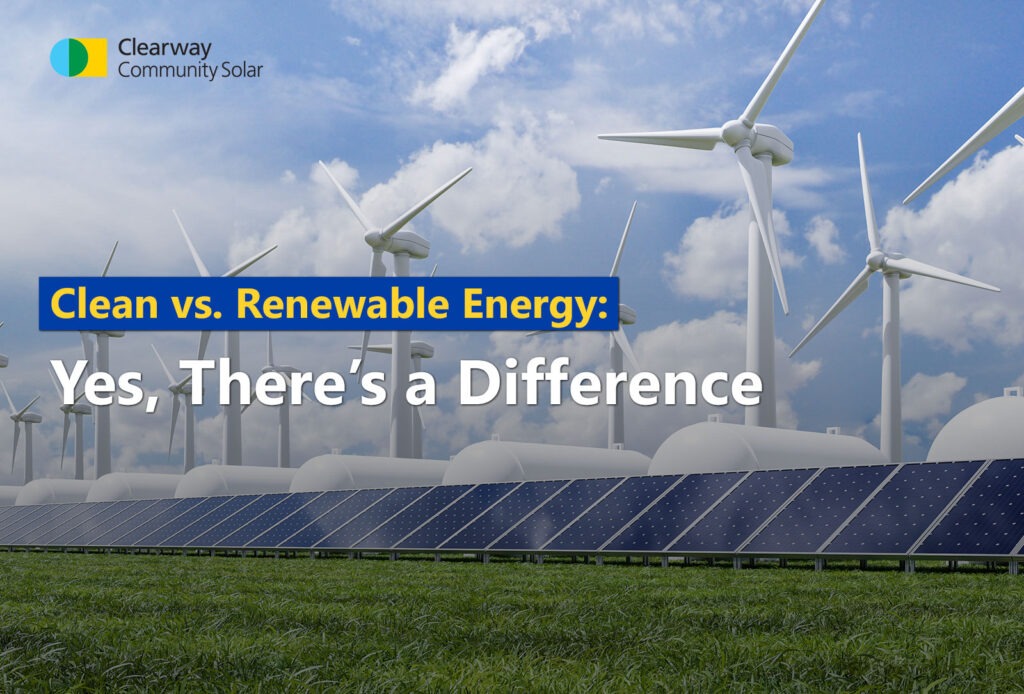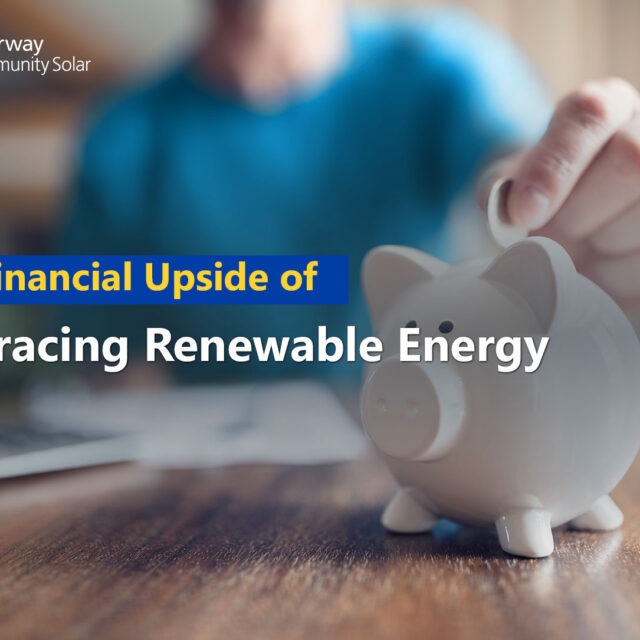
Ever since the topic of climate change took center stage in political and economic discussions, many businesses, organizations, politicians, and online content creators mistakenly use the terms “clean energy” and “renewable energy” interchangeably without realizing the important differences between the two.
Below, we’ll summarize the most common misconceptions and provide a more clear definition of “what is clean energy,” “what is renewable energy,” and how they differ.
What is Renewable Energy?
Renewable energy is energy that is produced from resources that replenish themselves naturally over short periods of time or that never run out at all. These resources are not considered finite, and there is no true “extraction” involved. Let’s look at a couple examples:
- Renewable Energy: The sun provides energy to Earth’s surface every day in the form of heat. By putting solar panels in the path of the sun’s rays, heat energy is being converted for electricity generation without depleting the source. This makes solar energy a renewable resource.
- Non-Renewable Energy: When natural gas is extracted from Earth and then burned to produce energy, that carbon-based resource has been extracted and converted into an unusable form of carbon — carbon dioxide — that will have to go through the carbon cycle over hundreds of millions of years before it is usable carbon again. Because that resource cannot be used again, it puts natural gas and other fossil fuels in the category of non-renewable resources.
Types of Renewable Energy
Renewable power generation is an exciting topic with so many interesting possibilities. Some of the most common types of renewable energy sources are:
- Solar Energy: harnessed by photovoltaic (PV) solar panels converting sunlight into electricity through the use of solar cells.
- Wind Energy: harnessed through the kinetic energy of naturally moving air passing through wind turbines located either on land or offshore.
- Geothermal Energy: Geothermal heat is extracted from geothermal reservoirs inside Earth’s crust and hot fluids are used to generate electricity.
- Hydropower: When water flows from higher to lower elevations, such as in a river, the kinetic energy is then used to produce electrical energy.
- Ocean Energy: The kinetic energy from the movement of waves and currents or from tidal energy is used to produce electricity or heat.
- Biomass Energy: When dead organic matter (e.g., wood scraps, sawdust, crop waste, and animal waste) decomposes, it releases energy. This waste can instead be burned to heat water, producing steam that spins a turbine and powers a generator that creates electricity.
Benefits of Renewable Energy
While there are many benefits to using renewable energy resources, the most notable benefit is its infinite supply. There have been countless international conflicts and wars fought to control the supply of non-renewable resources. With a limitless supply, energy sources, like solar and wind, can be used globally without any specific countries controlling the resource.
See more benefits of renewable energy.
What is Clean Energy?
When the production of electricity does not release any greenhouse gasses, this is considered clean energy. Many renewable energy sources are also considered clean energy sources. Nuclear power is the one major exception to this, because electricity is generated through the nuclear fission of a non-renewable resource — uranium.
Types of Clean Energy
- Solar Energy: Solar energy technologies and solar power plants do not produce air pollution or release greenhouse gas emissions into the atmosphere.
- Wind Energy: The electricity generated by wind turbines does not release carbon dioxide or other greenhouse gasses.
- Geothermal Energy: This type of energy relies on the use of natural heat sources, meaning electricity can be generated without burning fossil fuels or releasing greenhouse gasses.
- Hydropower: Since hydropower uses the flowing energy of water and does emit greenhouse gasses, it is considered a clean energy source in terms of emissions. Hydropower does, however, cause environmental impacts in the form of altering natural water flows and re-engineering natural animal habitats, due to dams and reservoirs.
- Ocean Energy: This relies on the water’s natural movement to generate power and does not release any greenhouse gasses into the atmosphere.
- Biomass Energy: Even though biomass energy sometimes involves the burning of dead or organic matter, which releases some greenhouse gasses, it is still often considered clean energy. This is because the biomass used for biomass energy comes from recently living organisms. In contrast, burning fossil fuels releases carbon that would have remained locked up for millions of years in geologic reservoirs if left untouched. The carbon in biomass is not from a long-term reservoir, which means it can continue to be exchanged in the carbon cycle.
- Nuclear Energy: Nuclear plants generate power through either nuclear fusion or nuclear fission, which involves fusing or splitting uranium atoms to produce energy. This process is considered clean energy from an emissions standpoint because it does not produce greenhouse gasses. Nuclear energy does, however, produce radioactive waste, which is a major environmental concern.
Benefits of Clean Energy
Like renewable energy, there are many benefits of shifting to clean energy resources. This type of green movement can have a major positive impact on the global environment. Here are some of the key benefits:
- Mitigates Climate Change: Clean energy doesn’t release greenhouse gasses, directly combating global warming.
- Enhances Energy Independence: Using domestic clean sources reduces dependency on foreign energy imports.
- Protects and Nurtures Ecosystems: Fewer pollutants result in healthier air, water, and biodiversity.
- Sustainable and Low-Impact: Many clean energy options are also renewable, offering long-term solutions with minimal environmental disruptions.
Can Energy Be Both Clean and Renewable?
Yes, while clean energy and renewable energy are two completely distinct concepts, many energy sources are considered both clean and renewable.
There are some renewable energy sources that emit zero emissions during energy production and are truly a clean energy source, such as solar and wind power, while there are other renewable sources of energy, like biomass energy, that do emit pollutants, but are still considered clean because of the type of carbon being used and released.
How Both Types of Energy Benefit the Environment
Both clean and renewable sources of energy are much better for the environment than burning fossil fuels. By relying on renewable resources rather than non-renewable ones to power our energy grids, we are ensuring that we don’t use up Earth’s natural resources at rates that are faster than the natural processes on Earth can keep up with. Using renewable energy sources also makes the United States less dependent on other countries for energy supplies.
Choosing to incorporate more clean energy solutions into the U.S. energy mix means that we will be releasing fewer harmful pollutants, which will make our air and water cleaner and our ecosystems healthier. Since the United States is one of the world’s largest contributors to global warming by burning greenhouse gasses, switching to more clean energy sources and burning less fossil fuels would make a considerable dent in slowing down the impacts of global climate change.









